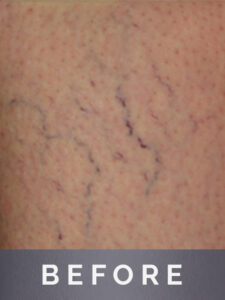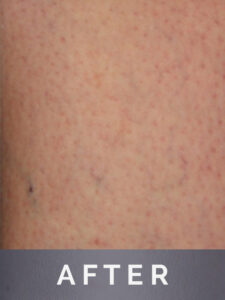YOU have questions,
WE have answers
The Asclera Difference
The Only FDA Approved Liquid Polidocanol in the US
What is Asclera?
Asclera (Polidocanol) Injection is an FDA approved prescription medication used for the treatment of spider and reticular veins in the lower extremities.¹ Asclera is injected into affected veins, causing them to seal shut and be reabsorbed into the body. The affected veins then fade from view over time.
Asclera is available in both 05% and 1%.
Why Should I ask for Asclera?
The Asclera difference is quality and consistency. Investigations have shown that non-Asclera products jeopardize patient safety and treatment success. Contamination, improper dosage, or undisclosed ingredients are common risks associated with these unregulated compounded medications.²
What Asclera Treats
Spider Veins (telangiectasias)
Indicated to sclerose uncomplicated spider veins (varicose veins ≤1 mm in diameter).¹


What Asclera Treats
Reticular Veins
Indicated to sclerose uncomplicated reticular veins (varicose veins 1 to 3 mm in diameter).¹


FAQ
Get to Know AscleraFind our more information about the only FDA approved liquid Polidocanol in the US
FAQ
Get to Know Asclera
Find our more information about the only FDA approved liquid Polidocanol in the US
Please Note:
Please click on the icon marked (+) to expand each of the FAQ questions.
If you are using a screen reader, you can expand the FAQ question by selecting it and activating the ‘enter’ or ‘space’ key on your keyboard, depending on your specific screen reader commands.
What is sclerotherapy?
Sclerotherapy is a minimally invasive procedure administered by your healthcare provider to treat uncomplicated spider veins and uncomplicated reticular veins. The treatment involves the injection of a solution into affected veins.
What are spider veins?
Spider veins are very small, fine, red or blue veins that are less than 1 mm in diameter. They lie closer to the surface of the skin than varicose veins and may resemble a thin red line, tree branches, or spider patterns. Spider veins can be found on the legs and may cover a small or large area.
What are small varicose veins?
Small varicose veins, also known as reticular veins, are small blood vessels that measure between 1 to 3 mm in diameter and are also known as feeder veins. Small varicose veins can enlarge as a result of increased pressure in the vein or from weakened vein valves. You may have only small varicose veins or both small varicose and spider veins at the same time.
What causes spider and reticular veins?¹
Some factors that may increase your risk of developing them:
-
-
- Heredity. If other family members had varicose veins, there’s a greater chance you will too.
- Age. The risk of varicose veins increases with age. Aging causes wear and tear on the valves in your veins that help regulate blood flow. Eventually, this causes the valves to allow some blood to flow back into your veins where it collects instead of flowing up to your heart.
- Gender. Women are more likely to develop the condition. Changes in hormones due to puberty, pregnancy, menopause, or taking birth control pills may increase a woman’s risk of developing varicose veins.
- Pregnancy. During pregnancy, the volume of blood in your body increases. This change supports the growing fetus but also can produce an unfortunate side effect—enlarged veins in your legs. Hormonal changes during pregnancy may also play a role. However, there is minimal benefit in treating uncomplicated spider veins and reticular veins in the lower extremity during pregnancy and lower extremity varicosities that develop during pregnancy as they may spontaneously regress postpartum.
- Extra weight or obesity. Carrying extra weight can put additional pressure on the veins. Prolonged standing or sitting may also hinder the healthy flow of blood.
-
Other possible causes for varicose veins are ethnicity, posture, occupation, hormones such as estrogen and progesterone, primary valvular incompetence, and incompetent perforating veins.
Why should I ask for Asclera by name?
Compounded medications like non-Asclera polidocanol are not approved by the FDA. They have not been evaluated or verified for safety or effectiveness. In some cases, the drug may have even been created in unsanitary conditions. Recent FDA investigations² have shown that poor compounding practices can result in serious drug quality problems, such as:
-
-
- contamination
- too much or too little of the active ingredient
- additional ingredients that you may not be aware of
-
Be sure to ask your provider for FDA-approved Asclera for treatment of your spider veins in your legs.
How does Asclera work?
Asclera is a sclerosing agent that is injected into the vein. It works by damaging the endothelium, the inside lining of blood vessels. This causes blood platelets and cellular debris to attach to the lining of the vessels. Eventually, cellular debris and platelets cause the blood vessel to clot. Over time, the clotted vein will be replaced with tissue.
How satisfied are patients who use Asclera?
88% of clinical study patients were satisfied or very satisfied with their Asclera treatment after 26 weeks.¹ ³
How long is each Asclera session?
A typical session lasts 15 to 45 minutes. Generally, 1 to 3 injections may be necessary to treat a given spider or reticular vein. Repeat treatment sessions may be necessary. Any additional treatment sessions are usually separated by 1 to 2 weeks.
What should I expect after being treated with Asclera?
Following treatment, you’ll need to wear compression stockings. Compression stockings are designed to apply pressure to your lower legs, helping maintain blood flow, and reduce discomfort and swelling. Compression helps your legs heal and is necessary to reduce the risk of deep vein thrombosis.
Compression stockings or support hose should be thigh or knee high depending upon the area treated to provide adequate coverage.
| Treatment | Compression Hose: Length of Wear* |
| Spider Veins | 2-3 days |
| Reticular Veins | 5-7 days |
*Note: Recommended to wear compression stockings continuously for first 2 to 3 days following treatment.¹
Your doctor may recommend that you wear support hose only during the day for two to three weeks after that, depending on the severity of the veins treated. If you had extensive varicosities and multiple veins were treated, you may need to wear them for even longer.
You should also walk for 15 to 20 minutes immediately after treatment and daily for a few days.
How often do I need treatment to see results?
The number and frequency of treatments depends on the size of the vessels and their location. Ask your provider about an individualized treatment approach that is right for you.
Are there activities I should avoid after receiving an Asclera Injection?
For 2 to 3 days following the treatment, avoid¹:
-
-
- Heavy exercise
- Sunbathing
- Long plane flights
- Hot baths, hot tubs, or saunas
-
Be sure to ask your healthcare provider if you are uncertain about any activities you should avoid post-procedure.
Are there any possible side effects to Asclera treatments?¹
Temporary side effects may occur at the site of the injection, including:
-
-
- Bruising
- Raised red areas
- Small skin sores
- Darkened skin in the form of lines or spots
- Multiple tiny red blood vessels
-
These side effects usually go away within a few days to several weeks. Some side effects may take months or years to resolve.
Although rare, some individuals may experience serious side effects, which may require treatment. These can include:
-
-
- An allergic reaction. Severe allergic reactions have been reported following polidocanol use, including anaphylactic reactions, some of them fatal. Severe reactions are most frequent with use of larger volumes (> 3 mL). The dose of polidocanol should therefore be minimized. A provider should be prepared to treat anaphylaxis appropriately
- In rare cases, formation of small “burns” or ulcers form, usually due to leakage of Asclera into the skin. These will heal in time but may leave a scar
- Inadvertent perivascular injection of Asclera can cause pain. If pain is severe, a local anesthetic (without adrenaline) may be injected
-
Is there any reason I should not be treated with Asclera?
You should not be treated with Asclera if you:¹
-
-
- Have a known allergy to polidocanol
- Have an acute vein or blood clotting (thromboembolic) disease
- Are pregnant or nursing
-
Be sure to tell your provider about all the medicines you are taking, including prescription and nonprescription medicines, vitamins and herbal products.
REFERENCES:
-
- Asclera® Full Prescribing Information. Methapharm, Inc., Feb 2022.
- Mann MS, Munavalli, GS, Amatangelo LS, Morrison NS. Improper potency and impurities in compounded polidocanol. JDD. 2019;18(11): 1124-1127.
- Rabe E, Schliephake D, Otto J, Breu FX, Pannier F. Sclerotherapy of telangiectases and small varicose veins: a double-blind, randomized, comparative clinical trial of polidocanol, sodium tetradecyl sulphate and isotonic saline (EASI study). Phlebology. 2010;25(3):124-131.
- Fontana D. Vein breakthroughs. New Beauty. 2018;14(3):119.
